Kerry’s last post signed off at our exit from Tajikistan at the Kyrgyzstan border. The epic scenery continued on and we felt like we had just witnessed a spectacular fireworks display, the last scenes building to a crescendo as we exited the mountains before arriving out onto the high grassy plains of Kyrgyzstan.
We, and our bikes, survived the mountains in one piece. Other teams we met had serious car problems coming through the mountains of the Pamir’s. Many avoided the mountains all together. There were many instances of wheels needing to be put back on, holed fuel tanks, suspension failures, even blown engines.
Most of the cars that have gone this route and have got this far are Japanese. It is big effort to bring these tiny cars through these mountain roads, that were, in many places, terrible. We had an advantage that we could pick our wheel tracks in a way cars can not. But for the roads – that is the beast. In many areas, not maintainable in any better state given the harsh environment, remote and steep experiencing constant landslides.
For that cost, the souls that venture there get to have the place largely to themselves. Rarely did we pass or were passed by cars in many areas.
A few trucks in the mountains to the east of Khorogh bringing Chinese ‘stuff’ through to towns and villages along the original silk route – the exact route Marco Polo took. But the prized silk, no more – just cheap Chinese goods.
I purchased a soldering iron and solder in Khorogh to try and fix Kerry’s microphone which we first did in Iran but had failed again. Soldering iron was $2 and the solder 30c. Multiply by 5 or 10 for the same thing in Aus, but was typical Chinese quality. Solder flux and solder grade made is almost impossible to ‘wet’ the tiny wires. But we fixed it – soldered on the shop counter and epoxied it together in the street. We were back in business – to talk as we ride – makes the experience a joint thing at every moment.
Kyrgyzstan border was the easiest yet. Very welcoming and helpful. It is a very remote border so little traffic. Big change in culture into Kyrgyzstan. Yurts randomly spaced out across broad high grassy plains, snow covered mountains fringing all sides in the distance.
Large mobs of sheep and goats, also yaks herded by horsemen. Lots of horses. Probably a dozen at every mountain camp. The first time anywhere we have seen horses used for herding. Donkeys, in some parts we have travelled, but mostly on foot. We had arrived with a bang – all the imagery of traditional Kyrgz culture, immediate.
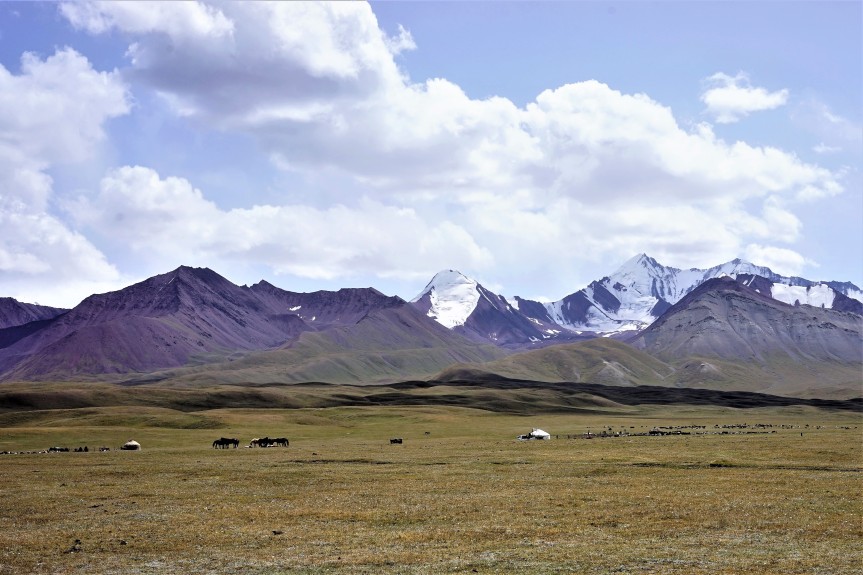
We landed in Osh for the night. A large bustling, typical central Asian city. Bazaars, melons, more melons, long ones, round ones, green, yellow, fruit stalls, vegetables stalls, more stalls, lining the roads. Pens of live sheep, to take home, not as pets.
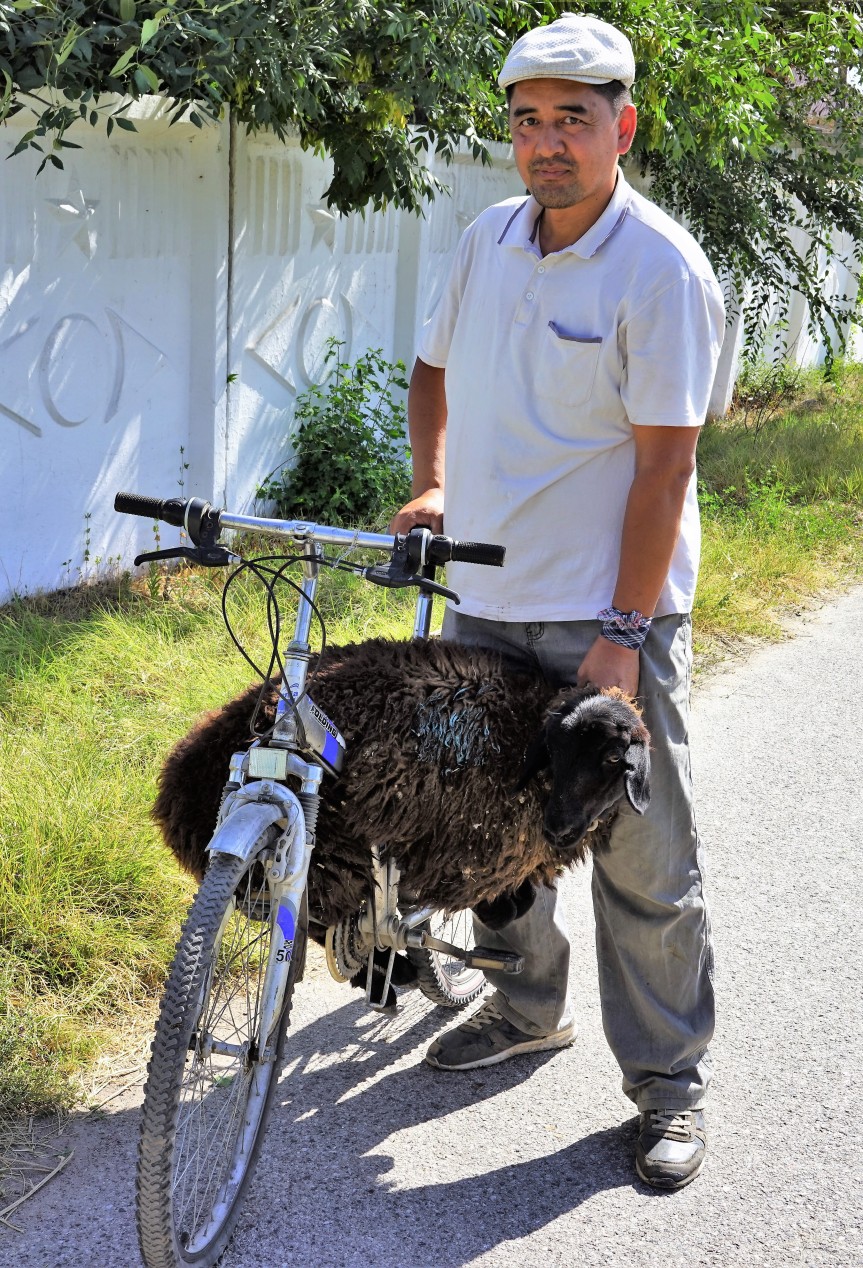
Next day we set out to the north with Bishkek in sight. The flat small scale, irrigated farming country, farmed largely by Uzbeks, giving way to mountains and high, cold, snowy plateaus to the north. This, again, the home of yurts, yaks, summer livestock (horses, Yaks, cattle and sheep) grazing – traditional, respected, folklore Kyrgz culture.
Horse milk and horse milk “balls” – we needed to find out what they were as they are for sale all along the mountain passes in front of the herder’s yurts. We each tried one of these “balls’. Luckily, we could both duck around the corner of the stall and eject it. Tasted like sour dried milk yogurt – flavor intensified by 10. That is story best left for Kerry to recite.
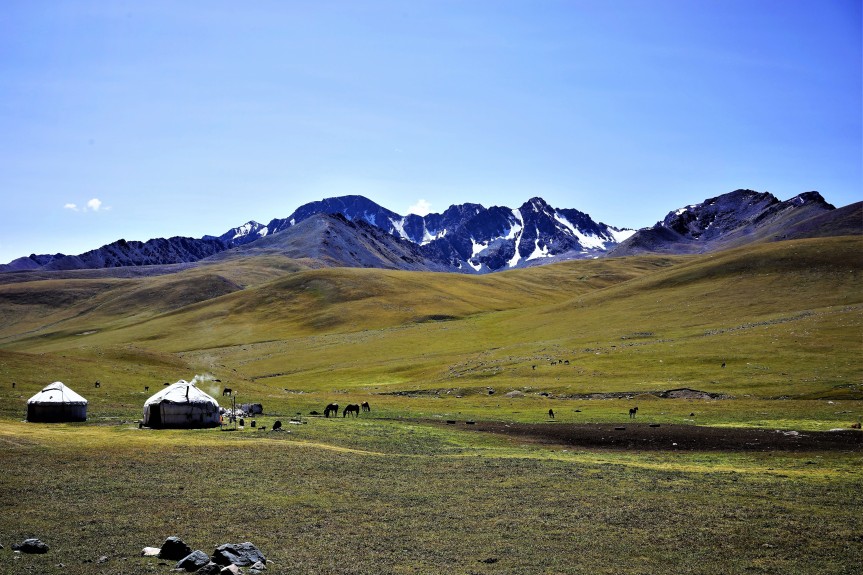
We were stopped by police in the mountains of Kyrgz and we both wondered why we had been pulled over. In these parts, lots a police stops along the way – typically a couple of cops, a car with tripod mounted radar set up by the road. We have avoided these stops so many times – they always have someone else pulled over. Anyway – Speeding! Sorry, but no, we were doing 60, I said, ‘What is the speed limit. Didn’t understand English. Do you speak Russ’ky, they asked. No, only English!
On they went, they were quite aggressive. Speeding, 87, they wrote on a piece of paper. Up hill, fully loaded posties? Not a chance. The story is long so I will cut to the chase. I noticed their tripod mounted radar pointing the other way, I turned and pointed to it, waving and raising my voice saying we were not speeding. He handed a handwritten note he had in his pocket that said they would take our licenses, we had to fill out a form, and that they would send our licenses back to our country,…….. I didn’t read any further nor did I want to suggest I could. Then I just kept talking in a loud voice, waving and crossing my arms as if to say, no, shook my head to suggest I couldn’t read or understand the note. They waved us on, to say, go, shoo. No bribe this time.
Other than that little downer, this days’ ride was epic and memorable. Roads vastly improved, scenery and traditional culture at every turn.
Skirting Bishkek, as we are wont to do, we headed straight for Almaty in Kazakhstan. The landscape now changed dramatically to flat broad, grassy rolling hills – herders still with big flocks as well as large areas of wheat. North, now, on the steppes of Russia so no more epic scenery for a while. Snow topped mountains and high mountain meadows and plateaus, largely behind for the next few days at least.
Kazakhstan, Almaty, is a more modern place now – the old Lada cars few that were characteristic 15 years ago, few and far between to be replaced by Lexus, Honda, Toyota, Mitsubishi and some German cars, all late model ripping around. Heavy traffic control puts a break on the madness a lot.
With three countries to go, close to 20 behind, Kerry commented, “I don’t want it to end”. For a rider of still limited skill, she has been brave and amazing. Still a concern as she fell twice in the Pamir’s, once in loose gravel in one section and rutted roads where the front wheel went one way, and she, the other. No injuries other than some bruises this time.
So, the whizzers arrive in Kazakhstan. On the steppe, The Great Steppe, centered in Kazakhstan and covering 800,000 square km.
There were three things I learned at school, in geography! I actually didn’t learn them so much as they have just stuck in a corner of my mind. These were words more than anything – Scree, the Russian steppes and the about India’s Ganges River. The first two, over and above the words themselves, I have learned about on this trip.
Firstly scree. Tajikistan has magnificent scree slopes – mountains slopes covered with loose stones shedding from vertical rocky cliff faces rising thousands of meters above you. So magnificent, they form their own constant angle of repose from top to base, banded into various colours as a result of variation in rock colors from which they are shed.
The other was ‘steppe’. Russia’s steppes. In school I learnt about this region, probably from the back row of the classroom, or, as directed, unwillingly, right at the front under the teachers nose, and thumb. One or the other at any point in time. But I learnt about steppes. These were “steps” – land rising up in steps. Russian steps. Very important that land rises in steps!
But they weren’t as I had envisaged. Steppes, finally, have turned out to be something entirely different.
Steppes are unique ecosystems – from wiki, “In physical geography, a steppe is an ecoregion, in the montane grasslands and shrublands and temperate grasslands, savannas, and shrublandsbiomes, characterized by grasslandplains without trees apart from those near rivers and lakes.”
https://en.wikipedia.org/wiki/Steppe
I knew it. A very important region! Here is a home to a plethora of flora and fauna as well as greatly significant farming and agricultural activities in this part of the world.
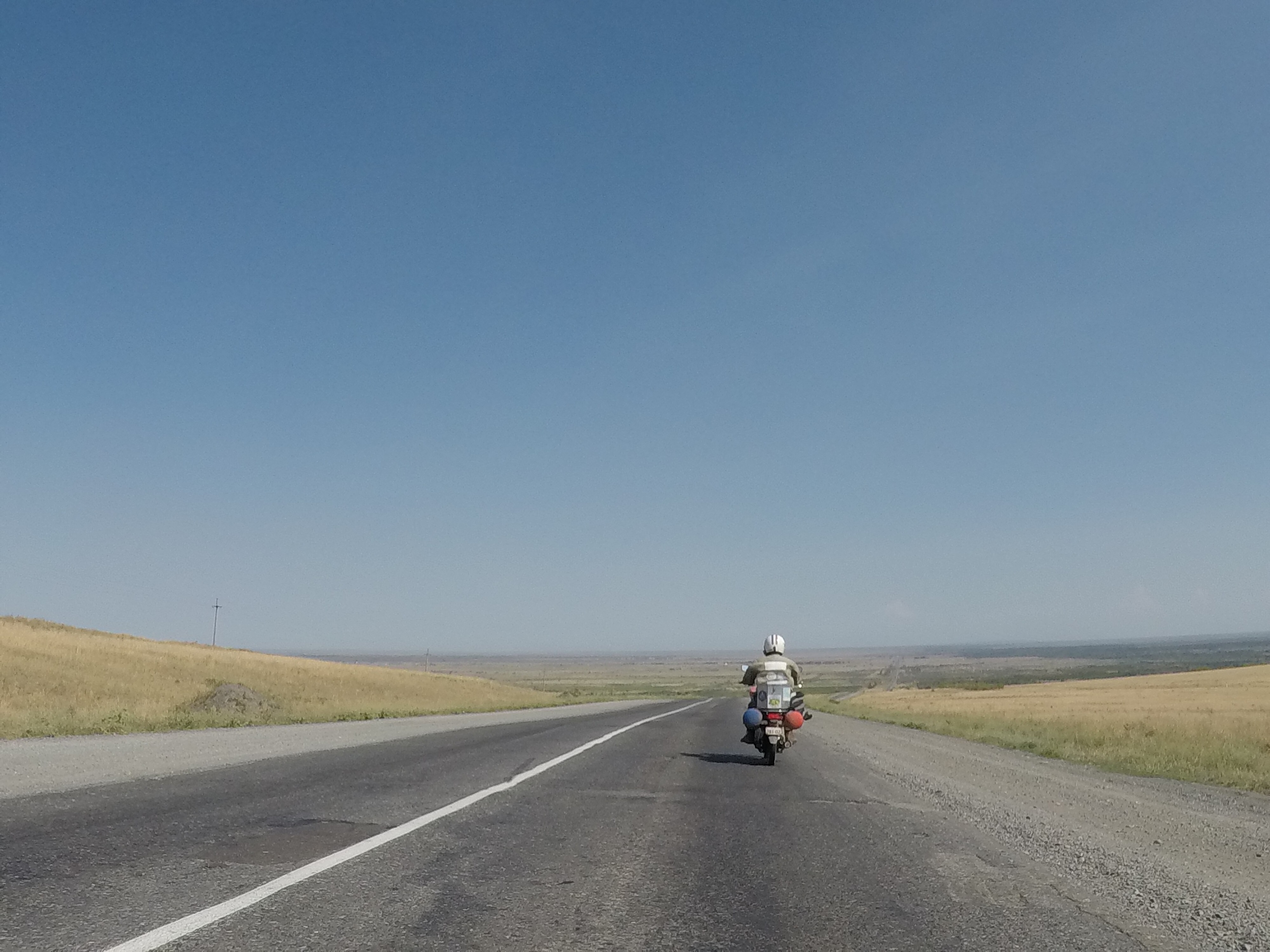
So, with that background, we came north from Almaty over the Great Steppe. And not a step to be seen. We had great roads for 200km then things started getting worse. Bitumen, but so badly disfigured, and broken in parts that trucks could do no more than 30kmh for long distances – like 100’s of km. Must be the cold winters. We have been able to do 60 to 70km most of the way.
We developed chain problems on both bikes. I fitted top quality o-ring chains before the bikes left Australia and I had fully anticipated they would go the distance. Not so.
We both, within about 100km (after now over 15000km) of each other, started getting ‘clickety clack’ noises when we rode in low gear. At first we checked over the bikes – several times and could not find the source of the noises but it did not appear to be mechanical issues with the bikes.
Then, 200km north of Almaty, in the middle of nowhere, well, in the middle of the Great Euro-Asian Steppe, to be precise, Kerry’s bike chain let go as she changed down a gear for the one hill in 1200km. Her bike had broken the chain joiner link and thrown the chain onto the road.
OK, time for the pitching wedge, we were in the rough.
We picked up the chain, found one half of the broken link then rolled back down the hill to the bottom (where there were some stalls selling melons) to assess and look for any other tools we could use.
The chain had three badly twisted links from where it wrapped around the sprocket as it left the bike but no serious damage to the bike. Looked to see if we had enough rear wheel adjuster travel to take another link out – luckily we did. I found part of a broken crow bar to use as a hammer and the tools I had to twist the three links back to close to normal, then used the bar, a rock and the broken link pin to drive out one of the solid pins in the chain end.
After about 30 minutes of filing the pin end using my Leatherman’s diamond file, (a normal file would not touch it), I had it fashioned allowing assembly on the bike, pushed in the pin and peined over the pin end to keep it in place. A couple of hours and we were on our way – but not until after first removing my joiner link to find the sealed in lubrication on the chain pins had been lost and the chain pins fretted to almost the point of seizing which was causing the clicking noises.
Lubricated and off we went. No more clicking for another 200km then it returned in my chain with a vengeance. We pulled into a disused garage, removed my chain and, feeling for stiff links, found several. On the ground where we had stopped, I noticed a broken razor blade, removed the blades and uses that to slide in between the link plates to cut and remove the o-rings. That allowed oil into the link pins and eliminate the friction.
Bingo. Quiet chain again. Late afternoon we stopped and tried to buy new chains in one town along the way but not to be – chains, yes, close to our size, but not the right ones. We rode on for another 150km through the evening arriving at a place on the steppe – Sarkand. In a tiny back street, we found the one hotel about – not quite a thousand star hotel, but in the clear cold night air here, the stars in the night sky were ablaze – and the room rate – USD7. It was perfect – hot shower, wifi and a bed.
We had come to the realization, if you have seen 100km of the steppe, you have seen a thousand, so, for the next, we put in a big day covering nearly 700km at and average speed of about 60kmh. One of those days you have to have. Just do it – we were tired by the end of it, by the middle of it actually. The most tiring day for me so far as the concentration required to constantly monitor every meter of road – it was that bad – but try to keep a good pace, was relentless.
With our limping chains, we arrived in Ektomeh – very close the to Russian border.
After the big ride across the steppe, The Great Steppe, we were, otherwise, looking pretty for a timely finish in Ulan Ude. Lots of teams now behind the Whizzers – we are the tortoises, the hares resting their tired cars after the mountains and many having to be towed into Almaty. Lost wheels, drive shafts, holed fuel tanks, broken wheels although all carried spares. But there is no respite heading north and only the courageous ones, with a will to be at the finish are still going at this stage. One Estonian rallier we met at our Hotel in Almaty had been bitten by some unknown insect and had hospital treatment in Kyrgyzstan, with one useful arm, put his front suspension back on his car twice, yet still had a big smile on his face and was going to finish. Four other lads, also at the hotel, were removing their engine to replace a piston, and totally replaced all suspension arms and drive shafts of their little Skoda – in the carpark. The spares they were able buy in the auto shops here were amazing. Things we would wait days or weeks for in Aus. They are a resourceful lot.
Some people are, but not everyone, as friendly as we had encountered further west and south. But our little bikes have come so far, over that terrain, this fact alone is normally good for a smile from the locals wherever we are.
We searched google maps for motorcycle shops planning to buy chains. Ektomek is quite big place.
The only chains, in fact the only ‘anything’ in the motorcycle shop was of Chinese origin. I don’t want to denigrate Chinese manufactured goods because they have their place – mostly in the rubbish bin – no, to their credit things are improving. We just need to give them more time, another millennium or do two would fix a lot of problems. As an Engineer, my experience is that Chinese steel has the tensile strength about that of hot camp fire roasted marshmallow.
The problem is, chains are made out of steel, as you would all know. Normally very high grade, specialty alloy steel. Given that, in 2016, China had only just, finally, managed to make steel of a quality suitable to use in ball point pens, no longer fully reliant on the Japanese or European steel for those special balls in their ends, I accepted their kind offer and purchased one for each bike. It had nothing, nothing at all, to do with the fact that 3 minutes up the road, with 4000km through Siberia and Mongolia still to go, our once very posh O-ring sealed, but now, fast wearing, worn out, Japanese chains were going to fail on us. It was simply my confidence in the Chinese and their ‘ball point’ break through that got the sale over the line.
I wanted to fit them then and there. I did not want another chain to fail while riding. Firstly, the safety aspects of who knows where it might happen – in front of a 50t lorry descending a hill – but that, as it comes away from the sprockets, damage to the bike – even an engine casing, is possible.
So with hand movements, I asked our Kazak shop owner if he had a chain breaker. “Ahhh, yes”, was the reply in body language.
So, with our booty in hand, out the front of the shop, we put both bikes on the center stand and began removing chains to the assembling crowd of local bikers and shop keepers.
Problem no 1. Chains are 98 links – two, too short. Ours are 100. Perplexed look on everyone’s face! I need another chain and two more joiner links. Trying to instruct the shop owner/keeper I need one more chain, did he have one – was an exercise in itself– or was it that he did have one but wanted to be sure we would pay for a third, maybe feeling a little at fault for them not being too short in the first place.
So, with the use of the workshop chain breaker and our tools, chains were cut and shut and fitted in no time. We were on our way.
Instantly, our marshmallow chains turned into XXXX chains, for want of a better 4 letter ‘word’. Well they sounded like someone running a butter knife around the serrated cap on a XXXX stubby. By the first 20m, sorry exaggeration, 10m, I said to Kerry, crikey, maybe Red has a gearbox problem, how is Ed? The clickety-clack had gone to be replaced by a steady beating growl at low speed and growling noise as the speed rose. We swapped bikes for 1 second. Ed was the same. Ball point pens, maybe, but not motorcycle chains – not yet anyway!
But on we press. Now 1000km and they are still there doing their thing – our XXXX chains – moving us forward at this point more important than the loss of our hearing.
As we came north through Ektomeh, the landscape changed dramatically from the dry desert steppe, the ‘Kazak Great steppe’ (my new word) that had been with us, grassy, sparsely populated, barely changed for a 1000km, interspersed only by an occasional feature – one being a spectacularly snow capped mountain range near Sarkand in central eastern Kazakhstan.
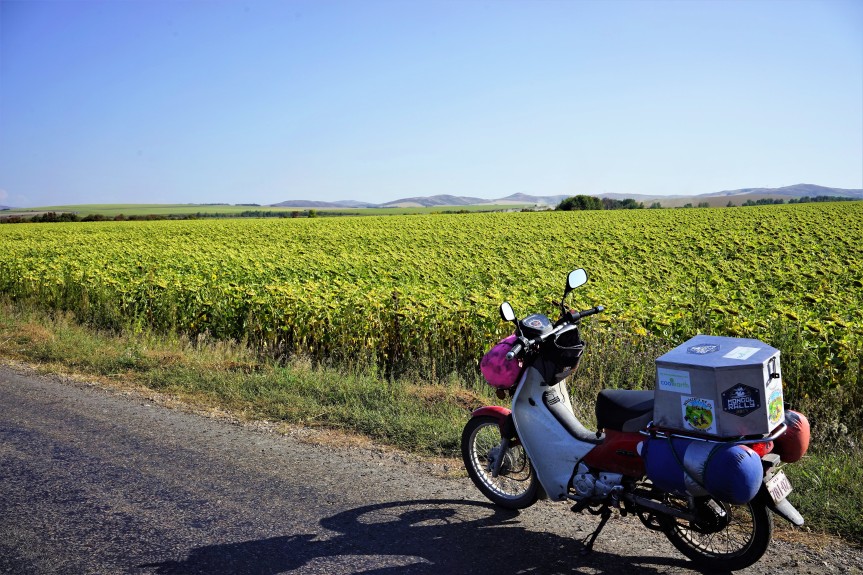
The farm land to the north and well into Russia is magnificent. Generally moderately undulating, clearly higher rainfall with soil types, rich, soft and friable akin the better soils of Australia’s magnificent Liverpool Plains or Darling Downs. Crops were the best we have seen since Europe. France comes to mind but Turkey had some good farmland, well farmed.
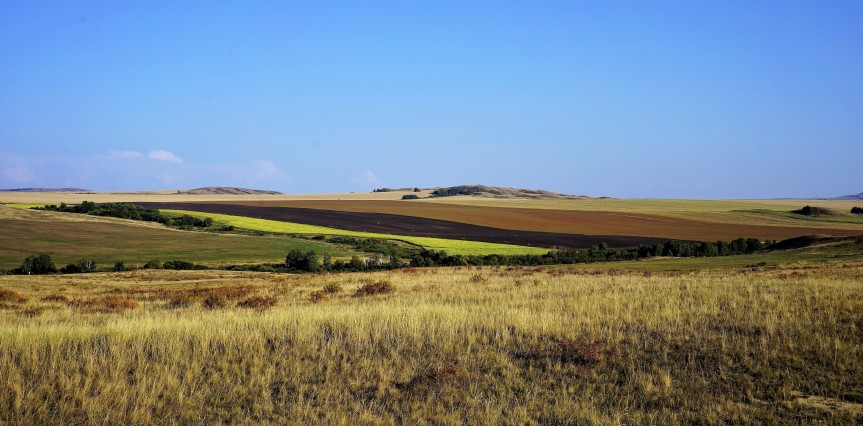
Just prior to crossing the border, we stopped to refuel at a small isolated roadside fuel station. Two big Russian-Kazakhstan blokes, on one scooter, wanted to know all about us and wanted selfies, video etc. They were so excited about it all. Somewhere, about 10 minutes into the whole shebang, they finally twigged that we were Aussies, from Aus…str..alia! Off they went, jumping and whooping around. More video, more selfies – then the bottle of vodka, the bottle of coke, the plastic cups, the local meat sausages, came out from under the seat. Along with 3 more bottles of Vodka, Pivo (beer) and dried fish. It is clearly a local delicacy but I baulked at the smelly dried fish. We both did. Kerry had Kazak belly so it was an easy excuse for her.
We came into Russia via Shemonaika gate as it was reported to be less busy with shorter wait times getting through. We arrived at the border late in the afternoon (it is a 24/7 border) and rolled right up to the gate, first in line to exit Kazakhstan. No problems. Over the hill through no mans land and we arrived at the Russian check. Again no real problems – just a little confusion with our Qld registration documents. Note to Australian States – Please put ‘Commonwealth of Australia’ above the state name on such documents. The number of times we have had to explain that Qld is an Australian state! Or is it? We could consult Bob Katter on that.
The area north of the Russian border is a spectacularly beautiful mix of exceptional farmland, arranged with fields following the landscape, nature strips and tree lines interspersing ripening crops akin to how the French have left so much nature intact despite intensive farming. There are signs of hope, huge signs, how to do things well, all over the world.
We were commenting, of all the peoples and cultures we have seen on this trip, the way they live, the respect for others, not one on them would be out of place fitting in and contributing to the best of Australian culture. Individuals, no doubt, might struggle, might sink, but in the main, they would do well. A crash course in keeping your rubbish in your car until the next bin, and anyone, if they wished could be in. The fact is, despite quite low wages in many countries, (but also low costs), most are clearly, and rightly so, very happy with their societies – and that fact alone contributes to a happy world. And further on that note, for the most part, people are the same people the world over.
When I first came to Kazakhstan 10 or 12 years ago, I marveled at their traditional villages, often in the middle of nowhere, here temperatures drop to and average of -20 in winter, but as cold as -50, daily tops of -12, to a destination were people, whole families, were packed and sent on trains from eastern Europe, from Ukraine and other places, before WW2 by German ethnic cleansing efforts, with 24 hours notice, the shirt on their backs, and a suitcase, if they were lucky. This time, nothing seems that different about the way they live having witnessed cultures, the way they do things, ebb and flow, from Europe to Asia. Remarkable that they live, survive and thrive in such harsh conditions but that is clearly within all of our characters.
It is also interesting to witness the involvement of children in many of the cultures we have just travelled through. They have duties, they have play, they appear to be in almost constant social situation with family and other kids, big and small. Their duties are clearly expectations of family and society that they do their bit, as we have witnessed many times – the mother who gave her youngish child the hotel room money, USD, for safe keeping, one example. The young boy, maybe around 8, certainly less than 10yo, leading a cow back home in the evening. The lad in the soup kitchen in Tajikistan. The fact they can drop whatever they are doing, sitting in groups in the street, climbing trees, a football game on a river ‘beach’ on the Afghan-Tajik border, running out of fields to meet us, does not suggest to me they are shackled to slave labour or unreasonable responsibilities. But there was not an IPad, a PlayStation, in sight. We might just have come through some of the last great places on earth to raise children.
You tend to learn a lot of things in life, and digressing, I will go back to my schoolyard days and give credit to my teachers, as I did learn more than those three things above. I learned some things in art class too, thanks mum, that blue and yellow, mixed, make green, and that every colour, mixed together, a mess. That’s still is true – with one exception, in the landscapes of Tajikistan!

And lastly, I learned that the ink in my English teachers blue Biro ran dry just as he began to mark my paper, and was forced to use RED, instead! That is true!


New car… it has jumped my van before.
Scott Dickson
M: 0459 777 797 Mascotte-2@bigpond.com
>
LikeLike
Hey Skottel. Not sure if this was supposed to be for us? 😊
LikeLike